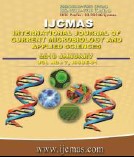


 National Academy of Agricultural Sciences (NAAS)
National Academy of Agricultural Sciences (NAAS)

|
PRINT ISSN : 2319-7692
Online ISSN : 2319-7706 Issues : 12 per year Publisher : Excellent Publishers Email : editorijcmas@gmail.com / submit@ijcmas.com Editor-in-chief: Dr.M.Prakash Index Copernicus ICV 2018: 95.39 NAAS RATING 2020: 5.38 |
A study was conducted to compare the carcass characteristics and meat composition of a triple cross progeny involving (Hansli × CSML) ♂and CSFL ♀ chicken, taken as the treatment group, with that of a cross of coloured synthetic broiler parent lines (CSML ♂ × CSFL ♀) chicken, taken as the control group, raised under intensive management system. Six healthy birds of 8 weeks of age from each group were sacrificed for this purpose. The pre-slaughtered live weight, eviscerated weight and dressed weight were 1256.67±110.67g, 826.33±74.54g and 905.00±78.54g in the treatment group whereas the corresponding weights were 1531.33±177.39g, 972.33±141.99g and 1063.00±152.51g in the control group. The dressing percentage was 72.03% in treatment group and 69.01% in control group. There was no significant difference between the groups among cut-up part yields such as neck, wing, back, breast, thigh and drumstick. The yields of edible offals such as heart, liver, gizzard were also similar between the groups. The yields of lymphoid organs such as spleen and bursa of fabricius were also found to be similar between the groups. There was no significant (p≥0.05) difference in chemical composition of breast and thigh muscles between the groups. However, the protein% in the treatment group was numerically higher and the fat% was lower than that of the control group.
 |
 |
 |
 |
 |